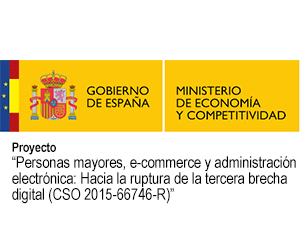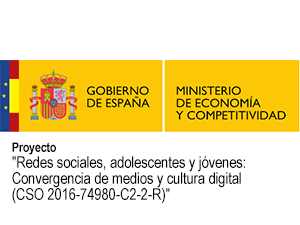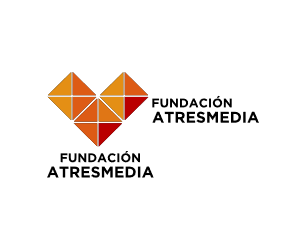Resumen
El contexto Web 3.0 permite la traslación de situaciones de bullying del mundo real al entorno virtual, en el que la difusión viral de los contenidos amplifica la situación de acoso. Partiendo de esta premisa, el presente estudio analiza la representación del ciberbullying en productos de ficción teen con la finalidad de comprobar cómo afecta su presencia en el peso narrativo de la trama. Asimismo, se exploran situaciones calificadas como “ciberbullying sexual”, entendido como la distribución de fotografías o vídeos de contenido sexual explícito con el objetivo de avergonzar o causar estrés emocional a la víctima (UNICEF, 2014: 71), prestando especial atención a situaciones de acoso que puedan estar vinculadas a violencia machista.
Con respecto a la metodología, se realiza un análisis textual en el que se valoran los siguientes indicadores: (1) cuantificación del uso de redes sociales, (2) efectos del uso de redes en la vida real de los personajes, (3) presencia audiovisual de dispositivos multimedia en pantalla y (4) presencia de dispositivos multimedia en diálogos. A continuación, se realiza un estudio comparativo entre textos audiovisuales que, aunque van a dirigidos a un mismo público meta adolescente, se inscriben en diferentes géneros cinematográficos, por lo que se estudia la relación entre bullying y forma genérica, examinando cuánto se alejan de la realidad representada o si, por el contrario, reflejan circunstancias y consecuencias vinculadas a escenarios reales.
Se establecen así los siguientes objetivos: (1) identificar situaciones de acoso virtual en diferentes textos audiovisuales, (2) analizar qué peso ocupan en el desarrollo de la trama (3) determinar si esas situaciones son contempladas de forma positiva o negativa, (4) observar si el género cinematográfico condiciona las situaciones de acoso representadas.
Como casos de estudio se han seleccionado tres películas exhibidas internacionalmente en 2015: El último baile (The DUFF, Ari sandel, 2015), catalogada como comedia romance; Cyberbully (Ben Chanan, 2015), etiquetada como drama, misterio y thriller; y Eliminado (Unfriended, Levan Gabriadze, 2015), inscrita en el terror sobrenatural.
El análisis comparativo de los resultados refleja una interesante aportación en relación al uso de los géneros cinematográficos, pues evidencia cómo un mismo tópico puede desarrollarse bajo múltiples ópticas y con una diferente importancia dentro de las tramas. Asimismo, se demuestra la dimensión social del cine, que a través de la reactualización de sus temáticas, pone el punto de mira sobre recientes problemáticas sociales derivadas de la convivencia digital.
Palabras Clave / acoso virtual / ciberbullying / cine adolescentes / estudios fílmicos
Abstract
Web 3.0 context has caused the migration of bullying situations from the real world to the virtual environment, in which the viral dissemination of contents has amplified the situation of harassment. Starting from this premise, the present study analyzes the representation of cyberbullying in teen fiction products with the purpose of checking how its presence affects the narrative weight of the plot. Likewise, situations described as «sexual cyberbullying» are explored, understood as the distribution of photographs or videos of explicit sexual content with the aim of embarrassing or causing emotional stress to the victim (UNICEF, 2014: 71). This concept emphasises those situations of harassment that may be linked to sexist violence.
With respect to the methodology applied, a textual analysis is developed based on the following indicators: (1) quantification of the use of social networks, (2) effects of the use of networks in the real life of the characters, (3) visibility of multimedia devices on screen and (4) references to multimedia devices in dialogues. Then, a comparative study is made between audiovisual texts aimed at the same teen target audience but catalogued under different film genres. With regard to this, the relationship between bullying and generic form is studied, examining how they deviate from the represented reality or if, on the contrary, they reflect circumstances and consequences linked to real scenarios.
The following objectives are established: (1) identify situations of virtual harassment in different audiovisual texts, (2) analyze what weight they occupy in the development of the plot (3) determine if those situations are assessed positively or negatively, (4) Observe the possible influence of each cinematographic genre on the way harassment is represented.
As case studies, three films exhibited internationally in 2015 have been selected: The DUFF, (Ari sandel, 2015), catalogued as a romance comedy; Cyberbully (Ben Chanan, 2015), labelled as drama, mystery and thriller; and Unfriended (Levan Gabriadze, 2015), inscribed in supernatural terror.
The comparative analysis of the results reflects an interesting contribution in relation to the use of film genres, since it demonstrates how the same topic can be developed under multiple approaches and with a different importance within the frames. Likewise, it demonstrates the social dimension of cinema, which through the updating of its themes, puts the focus on recent social problems derived from digital coexistence.
Keywords / cyberbullying / film studies / online harassment / teen fiction
FIRMANTES
| Nombre | Adscripción | Procedencia |
|---|---|---|
| Irene Raya Bravo | Universidad de Sevilla | Sevilla |
| Cristina Algaba | Universidad Loyola Andalucía | Sevilla |















